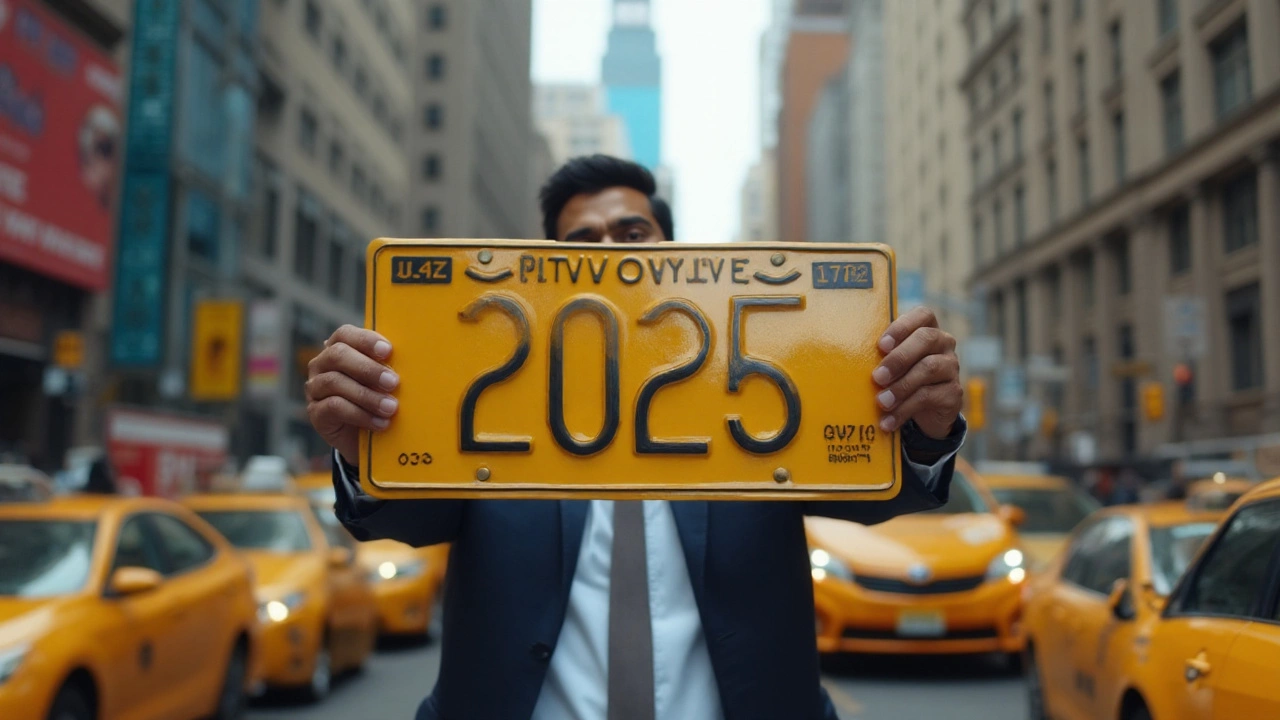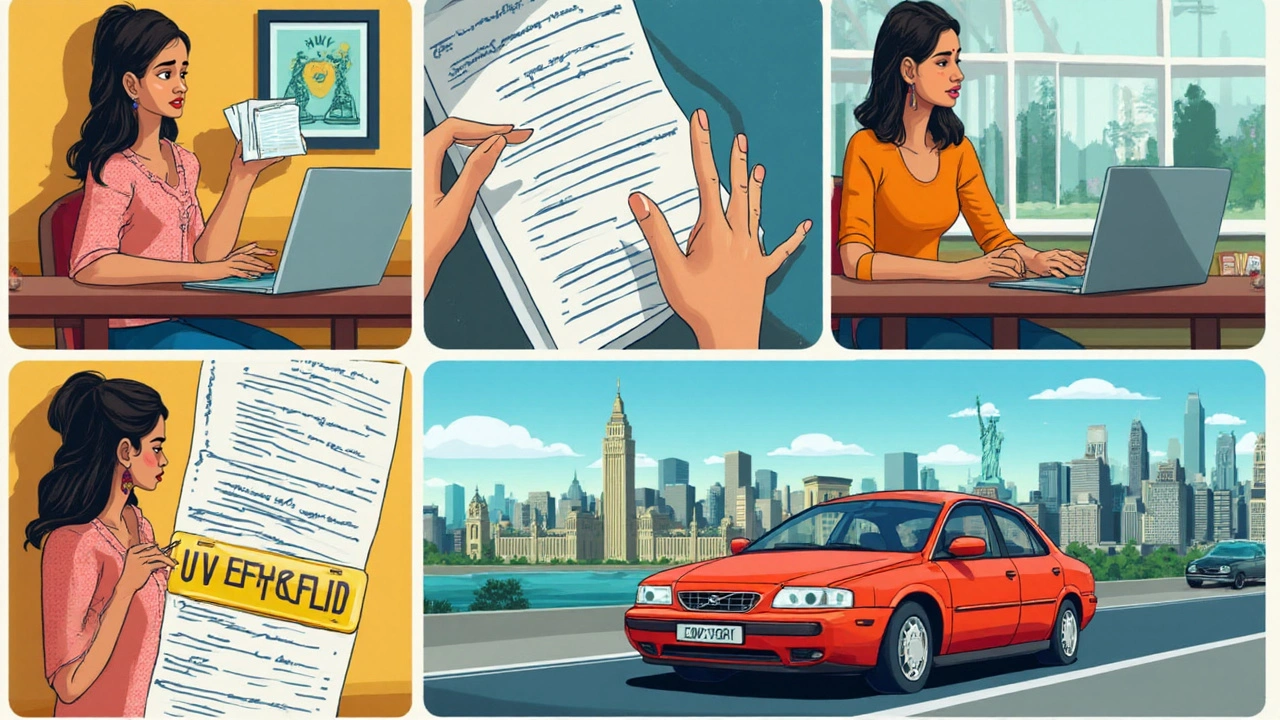How to Get a Yellow New York License Plate: Step-by-Step Guide in 2025

Weird to think that something as simple as a license plate can spark arguments, right? Nobody ever debates how to tie their shoes, but start talking about those classic yellow New York plates and people get fired up. Why? They’re iconic, bold, and—let’s be honest—they look sharp on just about any car. Tourists photograph them, collectors obsess, and locals debate if they love or hate the color. But if you want one for your own wheels, it’s a maze of forms, rules, and a strange dance with the Department of Motor Vehicles (DMV).
The History and Design: What Makes the Yellow NY Plate Unique?
Someone from outside New York might think all American plates look alike, but wow, there’s something unmistakable about that yellow background with a blue banner. The yellow plate isn’t just a paint choice—it’s practically New York’s calling card. They first appeared in 2010, after the state swapped out the white-and-blue 'Empire State' plate. But even further back, New York experimented with yellow and orange plates long before emojis replaced handwritten notes.
The official name: "Empire Gold." The state picked this color to mirror the plates from the 1970s and 1980s, partly as a nod to nostalgia and partly, so they say, to help law enforcement spot plates faster in bad weather. Try telling that to collectors nowadays—they’ll argue about which year’s shade was better, but most agree the bright yellow stands out in a sea of boring gray and white.
Who designs these things? It’s not some guy in Albany doodling between coffee breaks. The process runs through committees, with input from state officials and even some public commentary. It takes months of discussion just to settle on a font. Fun fact: New York’s yellow plate was criticized for its lack of the Statue of Liberty—but, weirdly, that made the plate more memorable. It’s all about simplicity now.
Statistics back up why people remember it. A survey in 2022 by the American License Plate Collectors Association put New York’s yellow plate in the top five most recognizable plates nationwide. Law enforcement reports from the state claimed that plate readability in rain increased by 23% over the earlier white designs. It’s not glamorous, but being easier to read helps with toll booths, red light cameras, and of course, traffic stops (nobody’s favorite topic).
Who Can Get a Yellow New York Plate?
Here’s where things get a bit wild. You’d think anyone could snag a yellow NY plate just by rolling up to the DMV, but not quite. Let’s break this down: only vehicles registered in New York State can legally display the yellow plate. If you move to New York, you’ve got 30 days to swap your old plates for shiny New York ones. Out-of-state friends with yellow souvenir plates? Sorry, not legal on the road. They’re just for the wall.
Classic car owners, here’s a twist. If you’re restoring an old Chevy or Datsun from the ‘80s, you might want a plate that matches the era. That’s called a 'vintage' or 'historical' registration. The DMV sometimes lets you use old, unused yellow plates from the correct period, but you have to have proof they were never assigned before. Find one at a garage sale and think you’re set? Hold on. If it was used, forget it. The DMV is strict: no double-use allowed.
Standard vehicles—meaning your daily commuter, van, or family wagon—get issued the latest state plate by default when you register or renew. Right now, it’s still the yellow Empire Gold plate. Some exceptions exist, mostly for government, police, or commercial vehicles, which sometimes get unique colors or formatting. If you want a personalized plate or a special design—disability, college alumni, or environmental themes—you’ll need to follow a slightly different process, and the color might not be yellow.
For lease holders, if you’re leasing a car, you need to register it in your name with the New York DMV before you can get the yellow plate. The leasing company may be the titleholder, but your name goes on the registration. So yes, Shadow and Mia (if cats and dogs could drive) would each need their own human co-signer to get a plate in New York.

How to Apply: Step-by-Step Process for Getting a Yellow New York Plate
Ready to actually get your plate? No sugarcoating: the DMV isn’t famous for quick turnarounds or instant gratification. But the good news—thanks to a wave of online upgrades in the last few years—it’s easier than it used to be.
- First, gather your paperwork. You'll need proof of identity, proof of New York residency (like a utility bill or lease agreement), proof of vehicle ownership (the title if you paid for it, or lease documents), and proof of insurance. Forget one, and you’re sent home—nobody fun, I know.
- Next, fill out application form MV-82, the standard one for registering passenger and commercial vehicles. You can do this online or grab a form at your local county clerk office (which in New York, is never further than a bagel shop or a pizza joint).
- Pay the registration and plate fees. New York’s initial registration runs about $26 for the registration, plus a $25 plate fee. Tack on extra charges if you want custom numbers or letters, or a special design. There’s also a $50 title certificate fee for new registrations.
- Submit your paperwork. Fastest option: the online DMV portal (dmv.ny.gov). Some counties let you drop forms at self-service kiosks, but it depends on where you live. In-person visits are still common, but expect lines—bring snacks, trust me.
- Wait for your new plates and stickers. They mail them to you, usually in two to four weeks. If the DMV is unusually busy (think back-to-school season or after big holidays), it might take a little longer.
A quick note, because someone always asks: yes, you have to surrender your out-of-state plates if you’re moving into New York. They want to make sure no old registration stays active. No exceptions.
| Step | Details |
|---|---|
| Gather documents | ID, NY address, title/lease papers, valid insurance |
| Fill MV-82 form | Vehicle registration application |
| Pay fees | Registration + plate + title; custom plates cost extra |
| Submit | Online portal, in-person DMV, or kiosk (availability varies) |
| Get plates | Mailed to you in 2-4 weeks; includes window sticker |
Renewals are easier—you can do them all online, and unless New York changes the plate design, you keep using your existing yellow plate until it’s worn or unreadable. Pro tip: If your plate gets damaged, don’t try to touch up the paint. That counts as altering a government document, and it’s a surprisingly big deal. Just request a replacement instead.
Tips, Tricks, and Common Mistakes
Even if you’ve registered a car before, New York’s rules trip people up. The most common goof? Forgetting to bring valid insurance or an updated title. Insurance must be from a New York-licensed provider—the DMV loves to reject out-of-state policies. Another classic blunder: filling out the MV-82 with a pencil or colored ink (yep, they want black or blue pen, nothing fancy).
- Bring two forms of ID, just in case. Different agents interpret 'acceptable ID' differently.
- Double-check the VIN (vehicle identification number) on every form. Mismatched numbers mean delays.
- If you’re buying used, make sure there are no liens against the car. The DMV will flag unpaid car loans, and it might take weeks to clear up.
- Trying to register a car in someone else’s name? They need to be present, or you’ll need power of attorney. No sneaking around this one.
- For vanity plates, order early. The DMV keeps a running list of banned or 'inappropriate' combinations—just try getting away with 'FASTNYC' and see what happens.
Watch for scams: websites that promise to 'expedite' New York plates for a fee. The state doesn’t use third-party registration companies. Only use the official DMV site or the physical DMV offices. Hear about 'backdoor' ways to get yellow plates out of state? Those end up cancelled or, worse, get drivers in trouble for fraudulent registration. Word gets around quick, and police do check for out-of-state fraud, especially in border areas.
Old plates still floating around? You can decorate your garage or man-cave with them, but don’t risk driving with one—you’ll likely get a fine. Until 2025, the Empire Gold plate is still the standard, but the state reviews plate designs every decade or so. New York nearly changed to a blue-and-gold design in 2020, but a public vote kept the yellow. Might change soon, but for now, that’s what you get from official channels.

Why Some Folks Love (or Hate) the Yellow Plate: Stories and Culture
I’ve lost count of how many times I’ve heard New Yorkers argue about the yellow plate at backyard barbecues or while waiting for coffee. Fans say it stands out, looks tough, and declares, “Yep, I’m from New York.” Haters mumble about garish colors or claim the yellow fades faster than other states’ plates. But in everyday talk, the plate’s identity sticks. Ever notice people in movies and TV shows fake New York car plates, but they never match the real thing? The yellow stands out too much to spoof accurately.
Collectors in upstate towns run swap meets just to trade old yellow plates from now-extinct counties or years. One guy in Albany even built his whole fence using nothing but old Empire Golds. In cities, the yellow plate means access—some parking lots won’t take cars with out-of-state tags because of rule changes in 2023 about local permits. Having a legit New York plate saves big headaches.
There’s also a safety side. School buses use a similar yellow that’s been proven to catch eyes in daylight and fog, and license plates borrow the same science. According to a 2023 state transportation study, the yellow improves night readability by about 15%. For taxi drivers, who spend hours waiting at curbs, the plate’s brightness helps drivers and riders spot them fasters during crazy Manhattan traffic.
And, the trivia nobody asked for: yellow pigment fades fastest if you wash the plate with harsh cleaning products. Stick to mild soap and water. My neighbor, a car fanatic, went wild with power wash and ended up with a pale orange plate. DMV swapped it, but not before friends cracked up for weeks.
In the end, getting a yellow New York plate is part DMV checklist, part rite of passage. It’s tedious, occasionally maddening, but walk out of that office with a fresh plate and there’s a real sense of arrival. After all, very few things scream "I really live here now!" like bolting that yellow splash to your bumper.







Write a comment